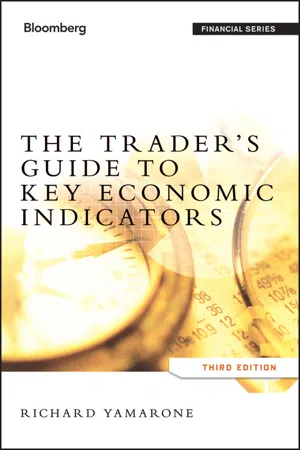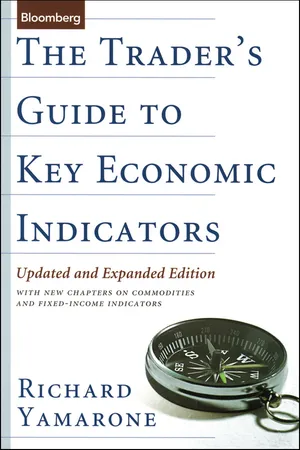Economics
Calculating Real GDP
Calculating Real GDP involves adjusting nominal GDP for inflation to reflect the true value of goods and services produced in an economy. This is typically done using a price index, such as the Consumer Price Index (CPI), to account for changes in prices over time. Real GDP provides a more accurate measure of an economy's output by accounting for changes in purchasing power.
Written by Perlego with AI-assistance
Related key terms
7 Key excerpts on "Calculating Real GDP"
- eBook - ePub
- Dan Richards, Manzur Rashid, Peter Antonioni(Authors)
- 2016(Publication Date)
- For Dummies(Publisher)
Remember, we’re imagining GDP as one single good. If that were really the case — if, say, we only produced oil — we’d have no trouble saying that if we produced 1,800 billion barrels of oil this year and next year, our real production hasn’t increased, even if oil prices doubled from $10 to $20. We would just divide the second year values by 2 to make the comparison. That same logic should apply to our fictitious single good called GDP.What economists are really interested in then is the actual amount of stuff — barrels of oil or pounds of sugar or units of GDP — that the economy is producing in a year. As the oil example indicates, to calculate that value, we have to purge our nominal GDP measure of price movement effects. If we don’t correct the nominal GDP values, we won’t know whether say a 5 percent increase happened because- The price level is unchanged and the actual quantity of goods being produced increased by 5 percent; or
- The price level increased by 5 percent and the actual quantity of goods being produced remained unchanged; or
- The price level increased by 10 percent and the actual quantity of goods being produced fell by 5 percent; or
- Some other combination of price level and real GDP changes.
From the viewpoint of real production and what people have available to them for consuming (or saving), the preceding scenarios are all very different, even though in all three cases nominal GDP has risen by 5 percent. Real GDP, however, has increased by 5 percent in the first case, remained unchanged in the second case, and fallen by 5 percent in the third case. Economists think that people should care about the amount of goods being produced rather than the nominal value of those goods, and so the changes in real GDP are what really count.In the base year, nominal GDP and real GDP are the same
As briefly noted, real GDP is calculated using the price level in the base year. Figure 4-1 shows the real and nominal GDP for the U.S. since 2006. Here, the base year is 2009, which means that real GDP in all other years is calculated using the prices of things in 2009. This approach allows economists to compare output in a meaningful way across time.© John Wiley & Sons, Inc. FIGURE 4-1: - eBook - ePub
A Primer on Macroeconomics, Second Edition, Volume I
Elements and Principles
- Thomas M. Beveridge(Author)
- 2018(Publication Date)
- Business Expert Press(Publisher)
Every day, the government publishes a great many economic statistics. Most of these are highly technical and of interest only to professional economists and other financial analysts and to policy makers. A few numbers, however, are widely reported, closely analyzed, and hotly debated by pundits in the media. The unemployment rate and the inflation rate, for example, may be of profound political significance, and unexpected or unwelcome changes in these values can trigger substantial changes in the stock market, which may affect our 401ks or other financial assets. The economic growth rate is chief among these highly significant numbers published by the government. To determine how rapidly economic production is growing, the government must first determine the level of economic production. It does this through national income accounting—the topic of our current chapter.National Income Accounting: Gross Domestic Product Definition of Gross Domestic Product and Exclusions from the DefinitionOur current framework of national income accounting began in the 1930s when the need was pressing to monitor the effectiveness of New Deal policy actions. The primary measure of total production used nowadays is GDP. GDP is defined as the total market value of all final goods and services produced within an economy’s boundaries in a given period of time.Note the definition’s emphasis on production. This year’s GDP measures the value of what is produced this year, not how much is bought and sold this year. For this reason, we are not interested in resold goods or second-hand sales. Our focus isproduction —these goods have only been produced once and, therefore, must only be counted once.THINK IT THROUGH : There are complications. The services of a recycling firm should be counted as part of this year’s GDP—the services provided are new and, therefore, require inclusion. Similarly, restoration services on a 1955 Cadillac that is then sold on eBay must be included—a productive service has been rendered.Note, too, the word “ final ” in our definition. Many goods and services are classified as - eBook - ePub
Macroeconomic Analysis and Policy
A Systematic Approach
- Joshua E Greene(Author)
- 2017(Publication Date)
- WSPC(Publisher)
Chapter 2REAL SECTOR ACCOUNTS AND ANALYSIS
As mentioned in Chapter 1 , an economy’s output, growth, and inflation are measured in the real sector of the economy. This chapter discusses the main elements of the real sector, including measures of actual and potential output and other macroeconomic aggregates; economic growth; and prices.I. ECONOMIC OUTPUT, GROWTH, AND EMPLOYMENT
A. Macroeconomic Aggregates: Gross Domestic ProductGross domestic product (GDP) is the most fundamental of the macroeconomic aggregates that describe an economy’s output, income, and total expenditure. GDP represents the total market value of final goods and services an economy produces. GDP is also the total value added by an economy: the value of all goods and services produced, less the value of all inputs used in producing these items.GDP can be measured in three ways. One is from the supply side (“GDP by sector of origin”), by aggregating value added in the various production sectors of the economy (agriculture; industry, including manufacturing, mining, construction, and utilities; and services, including trade, hotels, restaurants, finance, housing, the non-profit sector, and government). Another is from the demand side (“GDP by category of expenditure”), aggregating consumption and investment in the private and public sectors, along with net exports (exports of goods and services, minus imports of goods and services). The third is the income approach: aggregating all factor incomes: wages, interest, rent and profit, consumption of fixed capital (depreciation), and net indirect taxes (indirect taxes such as value added taxes (VATs) and excise taxes, less subsidies). Virtually all countries publish data on GDP by sector of origin, in both real and nominal terms, and most publish data on GDP by expenditure, at least in nominal terms. Typically, only advanced economies publish data on GDP by source of income. Tables 2.1 –2.3 - eBook - ePub
- Neil Harris(Author)
- 2007(Publication Date)
- Routledge(Publisher)
There are a number of problems, with using basic GDP statistics. If comparisons are made over time then this does not allow for increasing population, as with China and India. GDP per head of the population (GDP per capita) is therefore a better way to analyse GDP growth. The other problem is inflation. If nominal GDP grows at 5 per cent per annum, for example, and inflation is 6 per cent, then real GDP has actually reduced by 1 per cent per annum. The data above, being at current (nominal) prices does not remove the effects of inflation. Therefore, real GDP per capita is a better measure and comparator over time and between countries than nominal GDP.Additionally, comparing GDP of different countries involves converting to a common currency, e.g. dollars in Table 9.1 . However, the exchange rate may not show the purchasing power of a currency very well, e.g. £1 = $1.60 but, as a rule of thumb, in the US one can buy for $1 what it costs £1 to buy in the UK. Economists therefore use a purchasing power parity rate. This enables GDP to be measured in a common currency such that a given amount of money can buy the same amount and type of goods in both countries. If the reader wishes to explore this further he/she is referred to more comprehensive books; for the purposes of this book we do not address this further.Table 9.1 Comparison of leading countries’ GDP, $ billion, 1998.Country GDP $ billion EU members Austria 212.5 Belgium 250.5 Denmark 174.9 Finland 124.8 France 1433.9 Germany 2135.7 Greece 120.5 Ireland 83.2 Italy 1172.3 Luxembourg 16.7 Netherlands 377.5 Portugal 105.9 Spain 553.3 Sweden 226.9 UK 1357.2 Other Japan 3777.2 US 8230 Source: OECD, Economic Outlook, December 1999, NO. 66 © OECD 19999.3 The Components of Real GDPIn terms of expenditure, let us now remember that we distinguished between gross domestic product (GDP); gross national product (GNP), which was GDP minus net property income from abroad; and net national product (NNP) which was GNP minus depreciation at factor cost. NNP, we said, was also equal to national income. - eBook - ePub
Economic Indicators for Professionals
Putting the Statistics into Perspective
- Charles Steindel(Author)
- 2018(Publication Date)
- Routledge(Publisher)
levels of those aggregates. Consider an economy that produces only apples and oranges. In one year, 20 apples and 20 oranges are grown. In the next year, the crop is 21 apples and 21 oranges: 5% more of each. Of course, in this example, “real GDP” has grown 5%. But what is “real GDP?” Apples-oranges? Oranges-apples? Still, there are times we’d like to assign a unit to the level of real GDP. The solution is the index number: Pick, perhaps arbitrarily, some year as the “base.” Assign a value of 100 (or 1, perhaps) to indicate the base year level of aggregate production. The index value assigned to all other years is derived from the cumulative growth since the base year. If there has been a 20% gain through the fifth year since the base year, the index number value for that fifth year is 120. For years prior to the base year, the process is reversed: The index number reflects the growth from the year in question to the base year. For instance, if output grew 20% over the five years from one year to the base year, the index number value for that first year is 83.33 (100 is 20% greater than 83.33). In our apples-orange example, with 5% growth in one year, if the first year is the base, the real GDP level is 100 in the first year, and 105 in the second. If the second year is chosen as the base, the level of real GDP is 95.24 in the first year, and 100 in the second year (100 is 5% greater than 95.24). One reason for assigning arbitrary index numbers to the levels of real output (or to the levels of aggregate prices) is that it reminds us that all we can really do is make a relative comparison across time (or space) between aggregates. However, somewhat uniquely, real GDP levels are typically not reported as pure index numbers, but as “chained dollars.” The truth, though, is that under the “chained dollars” skin, real GDP levels are just index numbers.Returning to the mechanics of the computation of real GDP growth, the outputs of individual items don’t grow at uniform rates, and prices of goods and services are always changing, both in absolute terms and relative to each other. We would like to have some reasonably objective measure of the growth of the volume of aggregate output, and some corresponding measure of the growth of aggregate income corrected for price changes.We may think of applying some measure of aggregate price change, say that of the CPI, to apply to aggregate dollar output and income changes to get a measure of “real” changes in activity. But if we think about aggregate income as our measure of nominal activity it’s unclear what would be the right measure of price change to use. We need to divide observed growth in income by the growth of some 25 price measure. But which one? A price measure of interest to wage earners, like the CPI, may be growing at a very different rate than one of interest to corporate shareholders.When we look at the issue of correcting current-dollar (nominal) output (or spending) growth for price changes, though, the task of developing an aggregate price measure and computing aggregate real growth becomes clearer. It’s certainly possible to construct measures of physical output for any good or service. In many instances, we have hard physical figures (the numbers of cars sold, for example—abstracting from the genuine problem that not all cars are alike), while in other cases we can simply divide dollar spending on a product by its price. Going back to fruit, we may be able to observe physical apple production (the number sold) or, perhaps, rely on the numbers for the dollar volume of sales by apple-growers and divide by the price of apples. In any event, it’s a fairly straightforward exercise (at least conceptually) to develop estimates of physical output and prices for all the final goods and services included in GDP. Hence, we can, in principle, construct measures of the growth of real output for every product (of course, in practice, for many products there are substantial practical problems to overcome to do this). That leaves us with the classic problem of combining the growth of apples and the growth of oranges, if their growth rates aren’t the same. - eBook - ePub
- Richard Yamarone(Author)
- 2012(Publication Date)
- Bloomberg Press(Publisher)
statistical discrepancy , still remains—third quarter 2011 NNP, for instance, was $13.486 trillion and net national income was $13.435 trillion by the income-based calculation, a difference of $51.4 billion. This discrepancy reflects differences in the sources for data used in the two calculations. Those used in deriving national income are less directly observable, and so less reliable. As mentioned earlier, moreover, illicit expenditures are not reported or estimated.This section of the chapter has described the multitude of figures included in the GDP report, how they are related to one another, and how they are derived. Next come the nuts and bolts: how economists and traders use the report numbers in analyzing both big-picture issues, such as the future course of the business cycle, and smaller issues, such as when to put their money where.What Does It All Mean?
The GDP report contains a wealth of information about the nation’s economy. Each of its components tells a different story about a particular group, sector, industry, or activity. Not surprisingly, then, different market participants look at different sections and draw different inferences. Retail analysts, for instance, focus mostly on consumer spending. Those covering housing, construction, or real estate investment trusts (REITs) concentrate on the residential activity in investment spending. Defense-industry analysts focus on the national defense spending component of government consumption expenditures and gross investment. Fixed-income analysts and investors, ever wary of the eroding effects of inflation, concern themselves with the GDP deflators and GDP growth rate. Traders, who are always on the lookout for possible market movers, watch for numbers that contradict expectations, which they track carefully, often jotting them down in notebooks kept at their desks, for quick reference when the real figures are announced. - eBook - ePub
The Trader's Guide to Key Economic Indicators
With New Chapters on Commodities and Fixed-Income Indicators
- Richard Yamarone(Author)
- 2010(Publication Date)
- Bloomberg Press(Publisher)
This section of the chapter has described the multitude of figures included in the GDP report, how they are related to one another, and how they are derived. Next comes the nuts and bolts: how economists and traders use the report numbers in analyzing both big-picture issues, such as the future course of the business cycle, and smaller issues, such as when to put their money where.WHAT DOES IT ALL MEAN?
The GDP report contains a wealth of information about the nation’s economy. Each of its components tells a different story about a particular group, sector, industry, or activity. Not surprisingly, then, different market participants look at different sections and draw different inferences. Retail analysts, for instance, focus mostly on consumer spending. Those covering housing, construction, or real estate investment trusts (REITs) concentrate on the residential activity in investment spending. Defense-industry analysts focus on the national defense spending component of government consumption expenditures and gross investment. Fixed-income analysts and investors, ever wary of the eroding effects of inflation, concern themselves with the GDP deflators and GDP growth rate. Traders, who are always on the lookout for possible market movers, watch for numbers that contradict expectations, which they track carefully, often jotting them down in notebooks kept at their desks, for quick reference when the real figures are announced.GDP GROWTH
The annualized quarterly growth rate of real GDP is the headline number of the GDP report. As with most economic figures, strong positive postings are generally good news for the economy, corporate profits, and stock valuations. Not so for bonds, however. Inflation erodes the value of fixed-income securities, and more torrid economic growth is usually associated with higher rates of inflation.Market reactions—both positive and negative—are more pronounced when the announced numbers differ from the expected ones. The larger the difference, the greater the market move. Say the Street consensus for the third quarter was for an annualized GDP growth rate of 4.2 percent. On the one hand, a weak posting of between 1 and 2 percent would probably spark a sell-off in the stock market and boost the price of fixed-income securities, lowering yields. Stronger-than-expected growth of 5.5 to 6.5 percent, on the other hand, would be well received by equity traders and frowned upon by fixed-income dealers.
Learn about this page
Index pages curate the most relevant extracts from our library of academic textbooks. They’ve been created using an in-house natural language model (NLM), each adding context and meaning to key research topics.






